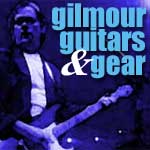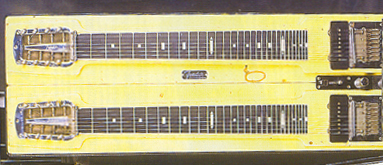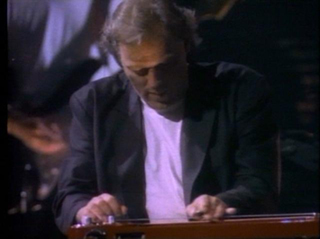


Gilmour, Guitars & Gear
Slide Guitars
 In this column, I'll be examining Pink Floyd guitarist David Gilmour's gear and playing techniques from a musician's point of view. Please feel free to e-mail me with questions and ideas for future articles if you feel you have an idea that readers of Spare Bricks might find of interest. Past articles are now posted here.
In this column, I'll be examining Pink Floyd guitarist David Gilmour's gear and playing techniques from a musician's point of view. Please feel free to e-mail me with questions and ideas for future articles if you feel you have an idea that readers of Spare Bricks might find of interest. Past articles are now posted here.
While we continue to examine David Gilmour's work, particularly where equipment is concerned, an overlooked aspect of his playing has been his use of slide, lap-steel, and pedal-steel guitars. As this edition of Spare Bricks features a look at Pink Floyd's instrumental work, it seems like a good idea to cover Gilmour's use of slide guitars, especially since they've been a focal point of quite a few instrumentals.
Even before Gilmour's time, Syd Barrett used the slide guitar effectively in his work with Pink Floyd. Barrett would use items as radical as a Zippo lighter and ball bearings in addition to a bottleneck slide. These can be seen in the video clips of the band at Sound Techniques Studio in London on January 11-12, 1967 during their first recording session. This footage can be seen in the Pink Floyd video release Pink Floyd-London 66-67. Barrett is also seen playing a slide guitar during a performance of "Astronomy Domine" on The Look of the Week, BBC-TV on May 14, 1967. The last sound on Pink Floyd's second single "See Emily Play" is a slide guitar.
 Gilmour's double neck Fender lap-steel guitar |
After joining Pink Floyd in 1968, Gilmour took an interest in slide guitar as a way to become a more versatile guitar player. While on tour in Seattle in 1968, Gilmour purchased two lap-steel guitars at a pawn shop. This same pair of Jedsen slide guitars (one red, one blonde) were used as recently as the 1994 tour in support of The Division Bell. He also owns a double neck Fender lap-steel guitar.
Gilmour's slide work shines through in tracks such as "One of These Days" from Meddle and "Mudmen" from Obscured By Clouds. The Dark Side of the Moon begins beautifully as Gilmour creates a symphony of layered slide guitars on the album's second track, "Breathe." One of the highlights of Pink Floyd's 9-part epic, "Shine On You Crazy Diamond" is Gilmour's superb slide work during part VI. On the title song from Wish You Were Here, "Comfortably Numb" from The Wall, and "Poles Apart" from The Division Bell, Gilmour uses a subtle slide effect to add an extra layer of sound to each song.
Gilmour has frequently stated a preference for pedal or lap steel guitars over the use of a conventional steel or bottleneck slide. There are a few instances of him using a conventional slide, such as "One of These Days" in the film Pink Floyd-Live at Pompeii. The film also includes footage of Gilmour moving the slide over certain sections of the strings to form notes, as seen at the opening of "Echoes." A slide is also used as a special effect in "A Saucerful of Secrets" in the film.
 Gilmour playing his red Jedsen lap steel guitar |
A pair of altered guitar tunings is favored by Gilmour for his slide guitars. For example, "High Hopes" from The Division Bell is tuned in an open E minor chord from top to bottom as E, B, E, G, B, E. "Great Gig in the Sky" from The Dark Side of the Moon is tuned from top to bottom as D, G, D, G, B, E. This tuning allows Gilmour to form a minor chord with the first three strings then form a major chord with the last three strings.
On his most recent DVD release, David Gilmour-In Concert, Gilmour also includes the use of a Gibson EH-150 lap steel guitar during the songs "Shine On You Crazy Diamond part VI" and "High Hopes."